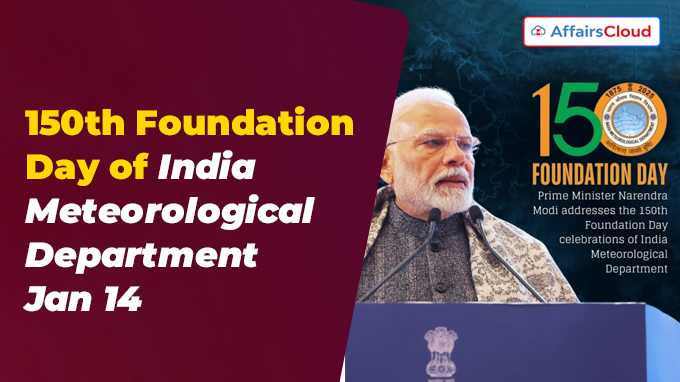 On January 15 2025, the India Meteorological Department (IMD) under the Ministry of Earth Sciences (MoES) celebrated its 150th Foundation Day. A series of events, activities and workshops were organised which demonstrated the contributions of IMD in making India climate-resilient and providing critical weather and climate services.
On January 15 2025, the India Meteorological Department (IMD) under the Ministry of Earth Sciences (MoES) celebrated its 150th Foundation Day. A series of events, activities and workshops were organised which demonstrated the contributions of IMD in making India climate-resilient and providing critical weather and climate services.
- Prime Minister (PM) Narendra Modi attended the celebrations held at Bharat Mandapam in New Delhi, Delhi.
Key People: Union Minister of State (MoS) (Independent Charge, IC) Dr. Jitendra Singh, MoES; Professor Celeste Saulo, Secretary-General of the World Meteorological Organisation (WMO) were present among the other key dignitaries at the event.
Key Highlights of the Event:
i.During the event, PM launched ‘Mission Mausam’, an initiative aimed to transform India into a ‘Weather-Ready’ and ‘Climate-smart’ country through advanced weather surveillance technologies, high-resolution atmospheric observations, among others.
- The Government of India(GoI) approved Mission Mausam in September 2024, with a budget outlay of 2,000 crores over two years.
ii.He also released commemorative postage stamp of Rs.5 denomination and coin to mark the 150 years of IMD.
- The coin is circular in shape with a denomination of Rs 150. It has been minted in 99.99% silver and weighs 40 grams (gms).
- On the obverse side of the coin, ‘satyamev jayate’ is inscribed in Hindi below the Lion Capital of Ashoka Pillar at its centre.
- The coin’s periphery is inscribed with ‘Bharat’ in Hindi on its left and India on the right.
- The reverse side of the coin has the special logo marking the 150 years of IMD. The lower periphery of the coin is inscribed with ‘150 Years of India Meteorological Department and the year 1875-2025 is written below the logo in international numbers.
iii.He also unveiled a vision document titled “IMD Vision 2047” which outlines a framework for weather resilience and climate change adaptation as India prepares to mark 100 years of independence in 2047.
- It also outlines targets for the next two years, the next 10 years (by 2035) and the next 22 years (by 2047), considering advancements in science and technology.
- According to the document, released on the eve of the IMD’s 150th anniversary, the weather department targets 100% forecast accuracy for up to three days, 90% for up to five days, 80% for up to seven days and 70% for up to 10 days, covering all severe weather events at the block and panchayat levels.
iv.IMD also organised a ‘Undivided India'(Akhand Bharat) seminar as part of the celebration.
About IMD:
i.IMD was established on January 15, 1875 during the British-colonial era. Since, its inception in 1875, IMD has played a vital role in advancing meteorology as a physical science.
ii.It has been playing an important role in alleviating the impact of natural disaster, supporting agriculture, water management, aviation, public safety and other key sectors and contributing to the socio-economic development of India and the wider region.
iii.It has 6 Regional Meteorological Centres: Mumbai(Maharashtra), Chennai(Tamil Nadu, TN), New Delhi(Delhi), Kolkata(West Bengal, WB), Nagpur(Maharashtra) and Guwahati(Assam).
Key Accomplishments of IMD:
i.Pioneering Weather Observations: By 2023, IMD has replaced all mercury barometers with digital barometers according to the United Nations Environment Programme’s (UNEP) Minamata Convention at all Class-I observations.
- Improved agro-meteorological services with the deployment of 200 AGRO Automatic Weather Stations(AWS) stations.
- Sustenance of 25 Global Positioning System (GPS) based PB stations in which 5 stations equipped with IMD manufactured and 20 are outsourced from Indian manufacturers.
ii.Communication and Outreach: In 2021, IMD launched its Crowdsource web interface and the mobile application (app) ‘Public Observation’ on 14th January, 2022, which permits the users to provide their weather feedback at anytime from anywhere.
- Since 2021, IMD has started an online platform to collect information of the weather that has occurred and also the associated impact information for 6 weather events initially: rain, hail, duststorm, wind speed, thunderstorm or lightning and fog.
iii.Advances in Numerical Weather Prediction: Overall forecast accuracy saw an improvement of 40% in 2023 as compared to 2014.
- Doppler Weather Radar (DWR) network has expanded from 15 (in 2014) to 39 (in 2023) with land area of coverage increased by about 35% from 2014.
- With the precise cyclone warning by IMD, the number of deaths has decreased from 10,000(in 1999) to 0 (in 20202-24).
iv.Technological Advancements: High-Resolution Rapid Refresh (HRRR) model for Nowcasting of Rainfall & Reflectivity forecasts.
- In January 2024, Vice President (VP) of India Jagdeep Singh Dhankar launched Mausamgram, an interactive and dynamic meteogram which provides location specific weather forecasts for public usage.
- The number of Automatic Rain Gauges (ARG) has increased from 1350 (in 2014) to 1382 (in 2023).
About India Meteorological Department (IMD):
Director General (DG)- Dr. Mrutyunjay Mohapatra
Headquarters- New Delhi, Delhi
Established- 1875
About Ministry of Earth Sciences (MoES):
Union Minister of State (MoS) (Independent Charge, IC)– Dr. Jitendra Singh (Constituency- Udhampur, Jammu & Kashmir, J&K)




